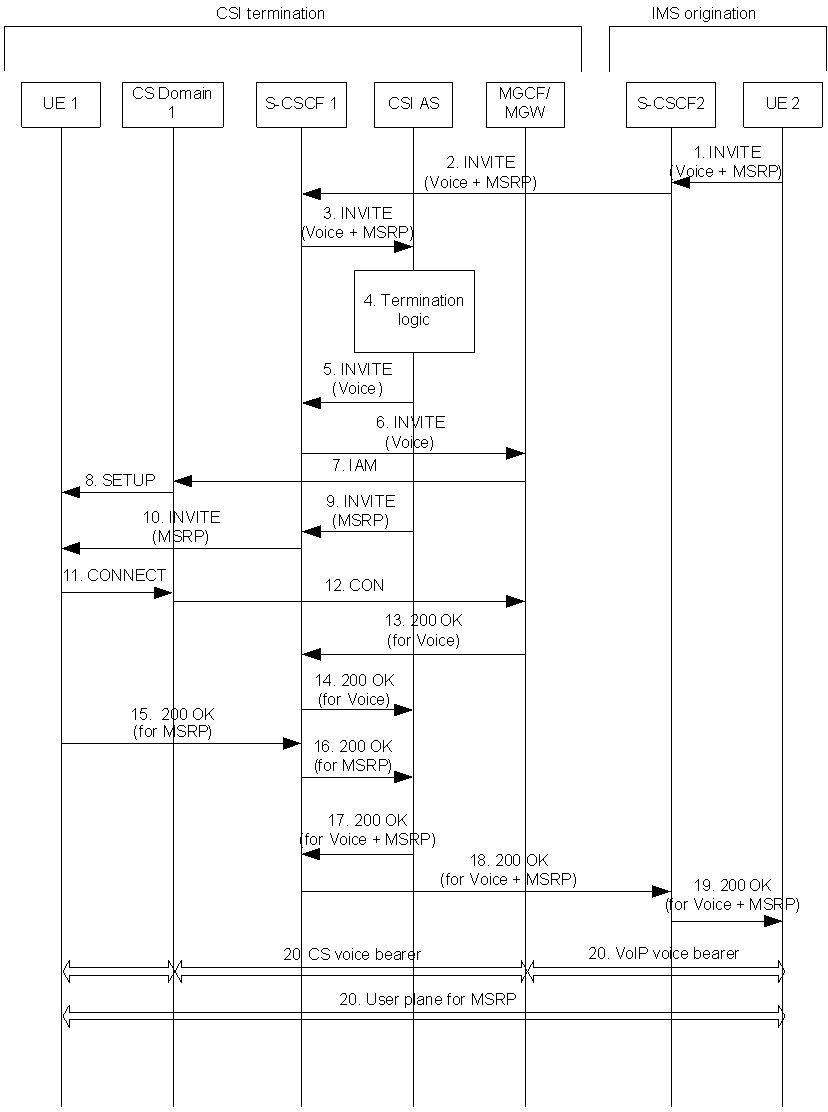Content for TS 23.279 Word version: 18.0.0
8.5 Release of CSI p. 23
The UE shall release the CS call and the IMS session independently of each other.
8.6 Terminating a Multimedia IMS session to a CSI UE p. 23
Figure 8.6-1 describes the call flow for a multimedia session (e.g. with both voice and messaging components of IMS origination and CSI termination. The assumption is that UE 1 is both CS attached and IMS domain registered. Also, the MSRP protocol is used for transporting the messaging component. Note that the procedure below is simplified for clarity, e.g. some entities are omitted, but the normal IMS procedure for IMS/CS interworking procedure shall be applied.

Figure 8.6-1: Call flow for terminating a multimedia IMS session to a CSI UE
(⇒ copy of original 3GPP image)
(⇒ copy of original 3GPP image)
The procedure is as follows:
Step 1.
UE 2 initiates the multimedia session for voice and MSRP by sending an INVITE message towards UE 1.
Step 2.
The S-CSCF 2 of the originating network sends the INVITE message for the voice and MSRP to the S-CSCF1 of the terminating network.
Step 3.
Triggered by the applicable iFC, the S-CSCF1 of terminating network sends the INVITE message for the voice and MSRP to the CSI AS.
Step 4.
The CSI AS invokes the Termination Logic (see clause 6.2) that decides to split the original IMS session into two sessions: One with the voice media component that will be terminated via the CS domain 1 of the terminating network and another with the messaging component that will be terminated via the PS domain. The CSI AS acts as a 3rd party call control entity for initiating and controlling these two sessions.
Step 5.
The CSI AS initiates the first session with the voice component by sending an INVITE message to S-CSCF 1 containing a Tel URI corresponding to UE 1 and any additional information to terminate the session in the CS domain.
Step 6-8, and 11-14.
Normal IMS/CS interworking functionality is invoked and a CS voice call is established toward UE 1 via CS domain 1 of the terminating network.
Step 9.
The CSI AS initiates the second session with the messaging component by sending an INVITE message to S-CSCF 1 containing a SIP URI corresponding to UE 1. CSI AS uses any information available to ensure to send the second session to the same terminating UE as the destination of the voice call.
Step 10. and 15-16.
UE 1 accepts the messaging session by sending a 200 OK message to CSI AS.
Step 17-19.
The CSI AS accepts the original INVITE message from UE 2 by sending to UE 2 a 200 OK response.
Step 20.
Finally, the CS voice bearer, the PS VoIP bearer, and the PS MSRP bearer are created.